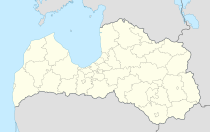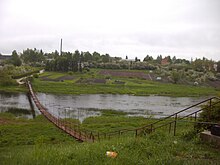Bauska
| Bauska ( German : Bauske) | ||
|---|---|---|
 |
|
|
| Basic data | ||
| State : |
|
|
| Landscape: | Semgallia ( Latvian : Zemgale ) | |
| Administrative district : | Bauskas novads | |
| Coordinates : | 56 ° 24 ' N , 24 ° 11' E | |
| Residents : | 9,348 (Jan 1, 2016) | |
| Area : | 6 km² | |
| Population density : | 1,558 inhabitants per km² | |
| Height : | 23 m | |
| City law: | since 1609 | |
| Website: | www.bauska.lv | |
| Post Code: | ||
| ISO code: | ||
(German Bauske,Polish Bowsk) is a city in theLatvianregion ofSemgalliaand the capital of the Bauska administrative district.
history
The city is located at the confluence of the rivers Mūša and Mēmele to Lielupe (Courland Aa) on low hills.
The fortress Bauska was in 1443 by the Teutonic Order to protect against the Lithuanian princes created. In 1609 the surrounding settlement received city rights. The castle has been destroyed since the Great Northern War and the population fell by 2/3 after a plague epidemic.
In 1797 937 inhabitants lived here (504 of them German). In the 1897 census, the population consisted of 2745 Jews, 2984 Latvians, 536 Germans and smaller groups of Poles, Russians and Lithuanians. In addition to a private boarding school for girls and a Jewish theological seminar, there was also a Latvian business school. After the revolution of 1905 , a revolutionary committee was able to last until the next spring.
During the First World War in 1915 almost half of the population was forcibly evacuated because of the advancing German army . In 1919 Bauska was the base of the Brandis Freikorps , which used the castle ruins to defend themselves against the Red Latvian rifle regiments. The Voluntary Latvian Company of the Bauska District, which submitted to the Freikorps until late summer, was unique in this period.
In 1939, at the beginning of the Second World War , the vast majority of the resident Baltic Germans were resettled in the Wartheland , which had just been occupied by the Germans . After the invasion of the Wehrmacht in 1941, more than 2000 Jews from the area were murdered by August. In September 1944, the city fell victim to a bomber attack when the Red Army was advancing north.
In the Soviet era, industry was established (including a wool factory) and workers from Russia were recruited for this purpose. The castle has now been restored.
traffic
Via Baltica (European route 67) runs through Bauska . The Latvian capital Riga is 67 km away. 14 km south of Bauska is the border crossing Grenctāle (dt. Border valley) to Lithuania .
Attractions
10 kilometers west of Bauska is Rundāle Palace (Ruhenthal Palace), an imposing Baroque complex, built 1736–1767 by Bartolomeo Francesco Rastrelli , the builder of the St. Petersburg Hermitage .
Twin cities
-
 Georgia , Khashuri
Georgia , Khashuri
-
 Poland , Rypin
Poland , Rypin
-
 Sweden , Hedemora
Sweden , Hedemora
-
 Czech Republic , Náchod
Czech Republic , Náchod
-
 Lithuania , Pakruojis
Lithuania , Pakruojis
-
 Lithuania , Radviliškis
Lithuania , Radviliškis
Bauskas novads
In 2009 the city merged with 8 surrounding communities. In 2010, 28028 inhabitants lived here (see also: Administrative division of Latvia )
Personalities
Sons and Daughters of the City (selection)
- Jakob Wilde (* 1679), historian, imperial historiographer in Sweden
- Theodor Lohding , master brewer, founded what was then the largest brewery in southern Latvia in 1873.
- Artuss Kaimiņš (* 1980), politician and actor
Associated with Bauska (selection)
- Bernhard Boettcher, pastor in Bauske since 1837
- Abraham Isaak Kook was a rabbi in Bauska from 1895 to 1904
literature
- Astrīda Iltnere (ed.): Latvijas Pagasti, Enciklopēdija. Preses Nams, Riga 2002, ISBN 9984-00-436-8 .
- Hanns Mahler: The town of Bauske, its mayors and families from the 15th to 19th centuries . In: Baltic pedigree and family tables. Special issue 18. Cologne 1998. pp. 5–28.



